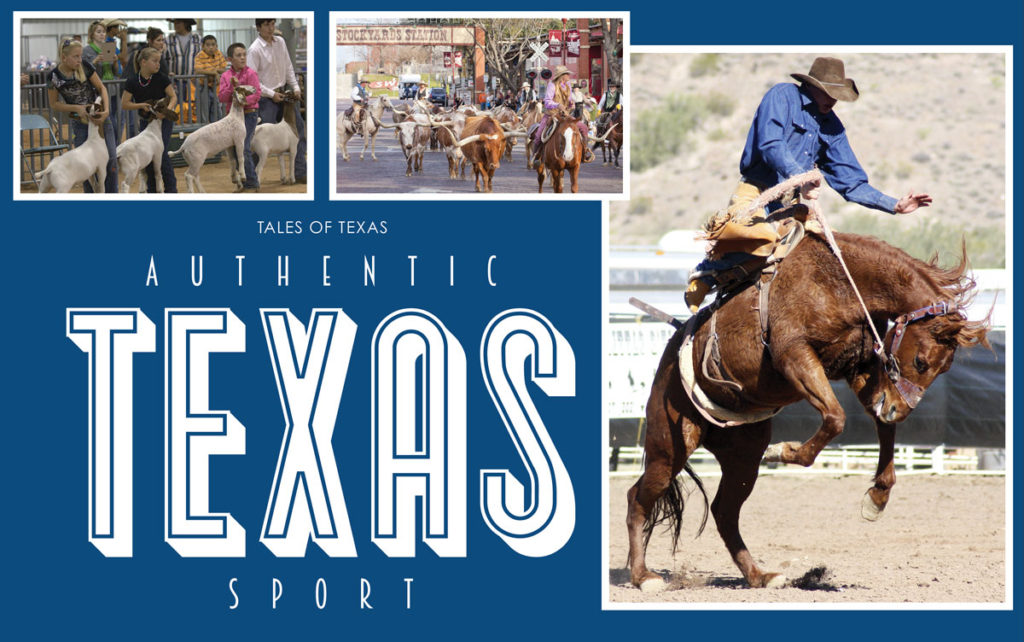
While Texans adore Friday night lights and other sports across the state, there is nothing quite like a rodeo. In the smallest counties across Texas, communities gather for both annual and regular events. That shouldn’t surprise us, considering the Lone Star State took a leadership role at the beginning of this beloved sport.
Rodeos grew from the cattle industry, though no one knows for certain where or when the new sport began. Several towns inundated with cows claim the first rodeo. Santa Fe, New Mexico, claims they held the first one in 1847. Deer Trail, Colorado, boasts an event in 1869. But Pecos, Texas, declares an authentic rodeo in 1883 — the first that offered prizes.
Rebuilding from war, large ranches and cattle drives ushered in a golden era of cowboys, attracting young men seeking adventure. As young men do, they showed off skills through competitions, often inviting cowboys from other ranches to claim bragging rights or money.
As the industry flourished in the Southwest, West Texas and areas in the Panhandle of Texas established large ranches. John S. Chisum, Oliver Loving and Charles Goodnight became well-known names, smaller ranches popping up beside them.
When fencing arrived in the late 1880s, however, the range cowboy experienced confinement. With communities building near ranches, holidays became social events and a perfect environment for cowboys to shine with abilities of roping, riding and wrangling. Some even honed their singing talents.
The railroad expanded, changing the way cowboys worked. During the off-season, many joined shows and rodeos, exhibiting ranch life skills. Rodeos became annual events in various places, enticing cowboys to follow. While some held only small contests, the first two rodeos on record consisted of the 1883 one in Pecos, Texas, and one held in 1888 in Prescott, Arizona, which was the first rodeo to charge admission. The first indoor rodeo took place in Fort Worth, Texas, during 1917.
According to World Atlas, more than in any other professional sport, residents of Texas played major roles in the development and leadership of rodeos. Texas boasts more hall of fame honorees than any other state, with more than 50 on record. And the Lone Star State quickly became the focal point of the professional sport native to the Southwest.
Then in 1997, the state legislature voted rodeo as the official state sport of Texas. Only two other states, Wyoming and South Dakota, share that designation for rodeo. In 1993, Mesquite, Texas, received a legislative declaration as Official Rodeo Capital of Texas because the city hosts more rodeo events than any other in the state.
Today, rodeo participation includes far more than the lonely range cowboy. The Women’s Professional Rodeo Association will celebrate its 75th anniversary in 2023. Once thought of as a choice between glam or grit, most women who ride professionally maintain both. They work and ride as hard as any man, looking beautiful doing it. Once considered a shameful display for women, professional female rodeo riders now command respect, admiration and wide publicity. Women compete, enjoying wonderful careers. Many use their fame for good causes.
Children, both boys and girls, also get involved at young ages. Many compete in mutton busting while between 35 and 55 pounds. Mini-bull riding events also bring in competitive kids, geared to their size and skill-levels. State requirements protect these junior rodeo lovers, especially their heads and faces. Like men and women of rodeo, the youngsters simply love the competitive aspect.
Throughout the years, Texas continued supporting the rise of rodeos. There are many organizations, like the Texas Senior Pro Rodeo Association, created in 1978, Texas Youth Rodeo Association, which caters to families, Texas Junior and Texas Junior High Rodeo Associations, and more. Anyone interested can find support and information. Many colleges in Texas also offer rodeo teams.
Often coupled with stock shows in Texas, the love of rodeo continues growing. The events provide an opportunity for families to experience something they may never live. A long way from the initial days of cowboys competing on the open range, Texans — both native and transplanted — have the chance to experience the thrill of animals and riders doing what they love.
While the sport of rodeo changed over the years, the spirit of competition remained the same. Everyone involved wants to do their best, ride away with bragging rights and perhaps with a little money in their wallets.
Sources:
1. City of Mesquite. “The History of Rodeo in the Official Rodeo Capital of Texas.” Visit Mesquite Texas. https://www.visitmesquitetx.com/p/articles/the-history-of-rodeo-in-the-rodeo-capital-of-texas.
2. Sylvia Gann Mahoney (1952, updated January 23, 2019). “Rodeos.” Texas State Historical Association Handbook of Texas. https://www.tshaonline.org/handbook/entries/rodeos.
3. Staff writer. “The History of Women in Rodeo.” Valencia Hotel Group Blog. https://magazine.valenciahotelgroup.com/the-history-of-women-in-texas-rodeo/.
4. Sophy Owuor (February 12, 2019). “What is the State Sport of Texas?” World Atlas. https://www.worldatlas.com/articles/what-is-the-state-sport-of-texas.html.
Written by Lisa Bell

You must be logged in to post a comment.